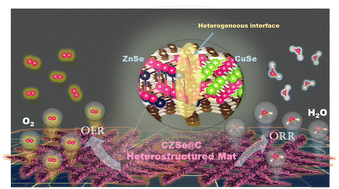Heterogeneous interface-induced electrocatalytic efficiency boosting of bimetallic Cu/Zn selenides for stable water oxidation and oxygen reduction reactions†
Abstract
An increased emphasis on alternative energy technologies paves the way for the design and development of highly active, cost-effective electrocatalysts for application in water splitting and fuel cells. In lieu of this, we evaluated heterostructured copper selenide and zinc selenide enwrapped in carbon nanofibers (CZSe@C-450) as bifunctional electrocatalysts synthesized by electrospinning and selenization. CZSe@C-450 demonstrated superior electrochemical performance with a low overpotential of 260 mV at 10 mA cm−2, high stability (1.2% loss in 12 hours and 9.9% loss in 50 hours) for oxygen evolution reaction, a half-wave potential (E1/2) of 0.88 V, and high stability (14.35% loss in 50 hours) for oxygen reduction reaction. The enhanced performance is attributed to the formation of a heterogeneous phase boundary between copper selenide and zinc selenide, which increases both the built-in potential and local atomic disorder. The lattice mismatch/disorder reduces the surface energy and leads to the creation of an ample number of active sites that participate in both oxygen evolution and reduction reactions.



 Please wait while we load your content...
Please wait while we load your content...